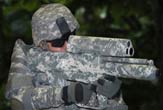Army Tests ‘Smart’ Rifle in Afghanistan

U.S. Army soldiers in Afghanistan are testing out a “smart” rifle that uses computer-chip-embedded rounds that can detonate behind walls.
Soldiers operating in various outposts with high levels of enemy activity began carrying these semi-automatic prototypes in November, and their feedback will be used to refine the rifle before the Army officially deploys the weapons in 2014.
This high-tech weapon — clad with sensors, lasers and optics — guides 25mm rounds, each embedded with a microchip, to a target up to about 2,300 feet (700 meters) away. Named XM25 and being developed by firearms producer Heckler & Koch, this rifle can detonate bullets — which act like grenades — after they pass a barrier, allowing soldiers to strike an enemy taking cover behind walls, rocks and trenches.
The new rifle could mean the difference between life and death for soldiers in the field, said John Pike, director of GlobalSecurity.org.
“The problem with what we have now is that troops in close fights basically have direct-fire weapons that they can shoot at a wall, but not over a wall,” said Pike, who was not involved in the smart rifle’s design.
Weapons such as mortars that can fire shells at high angles can do the same thing as the smart rifle, but “it takes a non-trivial amount of time to call for fire and for a mortar shell to get to its target … a non-trivial fraction of a minute,” Pike said. “I want to kill the enemy now and not half a minute from now.”
The feedback from U.S. soldiers in Afghanistan will be used to tweak the rifle before it is given to a larger number of troops in 2011. Then, starting in 2014, the Army is scheduled to issue 12,500 smart rifles to troops in Afghanistan.
Sign up for the Live Science daily newsletter now
Get the world’s most fascinating discoveries delivered straight to your inbox.
Here’s how the rifle works: A laser is built into the targeting scope that sits on top of the rifle.It measures the distance to a target — for instance, the wall that conceals a combatant. The soldier then can modify the distance — say,add a couple of feet — to allow the round to detonate past the wall.
When the soldier pulls the trigger, this information is wirelessly relayed to the computer chip in the shell.A magnet inside the bullet generates alternating current as it spins through the air, and it conveys information to the on-board microchip to let the bullet know how far it’s traveled.
Once the computerized bullet reaches its programmed distance, it will explode, spreading shrapnel evenly in all directions.
While considered by the Army as a “game-changing” technology, these smart weapons come with a hefty price tag -- $25,000 to $35,000 apiece.
But “compared to the life of a soldier, that’s cheap,” Pike said.










